Pricing Guides & Dictionary of Makers Marks for Antiques & Collectibles

A few examples of appraisal values for
THETIS
Search our price guide for your own treasures
-
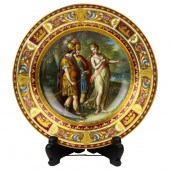 A VIENNA STYLE PORCELAIN
A VIENNA STYLE PORCELAIN MYTHOLOGICAL CABINET PLATE, SIGNED BARSCHNEIDER, EARLY 20TH CENTURY A Vienna style porcelain mythological cabinet plate, signed Barschneider, titled Ulysses, Thetis, Achilles, early 20th century, within a paneled border with enamel and gilt highlights, underglaze blue shield mark, together with giltwood frame, 9.5"dia (plate). Provenance: Property from the private collection of Stephen and Lynette Schwartz of Stephen's Antiques, Tiburon, CA
A VIENNA STYLE PORCELAIN
A VIENNA STYLE PORCELAIN MYTHOLOGICAL CABINET PLATE, SIGNED BARSCHNEIDER, EARLY 20TH CENTURY A Vienna style porcelain mythological cabinet plate, signed Barschneider, titled Ulysses, Thetis, Achilles, early 20th century, within a paneled border with enamel and gilt highlights, underglaze blue shield mark, together with giltwood frame, 9.5"dia (plate). Provenance: Property from the private collection of Stephen and Lynette Schwartz of Stephen's Antiques, Tiburon, CA -
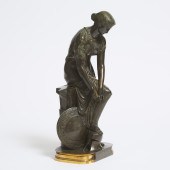 Pierre-Eugène-Émile Hébert (French,
Pierre-Eugène-Émile Hébert (French, 1828-1893) THETIS gilt and patinated bronze, signed height 15 in — 38.1 cm
Pierre-Eugène-Émile Hébert (French,
Pierre-Eugène-Émile Hébert (French, 1828-1893) THETIS gilt and patinated bronze, signed height 15 in — 38.1 cm -
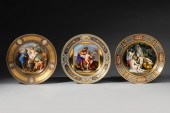 THREE ROYAL VIENNA PORCELAIN
THREE ROYAL VIENNA PORCELAIN CABINET PLATESThree Royal Vienna Porcelain Cabinet Plates, each with blue painted bindenschild mark and red-painted numbers, "Dadalus and Icarus" and "Thetis and Achilles" each also with impressed numbers; each hand-painted in colors with gilt borders Dimensions: Two 9 1/2 in. dia., One 9 3/4 in. dia. Condition:
THREE ROYAL VIENNA PORCELAIN
THREE ROYAL VIENNA PORCELAIN CABINET PLATESThree Royal Vienna Porcelain Cabinet Plates, each with blue painted bindenschild mark and red-painted numbers, "Dadalus and Icarus" and "Thetis and Achilles" each also with impressed numbers; each hand-painted in colors with gilt borders Dimensions: Two 9 1/2 in. dia., One 9 3/4 in. dia. Condition: -
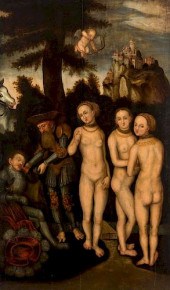 AN 18TH CENTURY PAINTING AFTER
AN 18TH CENTURY PAINTING AFTER LUCAS CRANACH THE ELDERAN 18TH CENTURY PAINTING AFTER LUCAS CRANACH THE ELDER The Judgement of Paris , oil on panel 103 x 62 cm (40 1/2 x 24 1/2 in.) LOT NOTES This early version of The Judgement of Paris inspired by a panel on the same subject by Lucas Cranach the Elder (in the collection the Metropolitan Museum of Art, New York) depicts the genesis of the Trojan War and the events that would lead to the city`s eventual demise. The languid figure of Paris is shown in the lower left, about to be woken up by Hermes with a request to determine which of the three goddesses presented, Hera, Aphrodite and Athena, is the most beautiful. Hermes is shown holding a golden apple, which according to legend, was inscribed by Eris (the goddess of discord) to the fairest , after she was not invited to Peleus` and Thetis` wedding, and thrown amid the gods into the celebration. Aphrodite won Paris` favour by promising him the love of Helen, the most beautiful mortal woman, should he select her to be the recipient of the coveted prize.
AN 18TH CENTURY PAINTING AFTER
AN 18TH CENTURY PAINTING AFTER LUCAS CRANACH THE ELDERAN 18TH CENTURY PAINTING AFTER LUCAS CRANACH THE ELDER The Judgement of Paris , oil on panel 103 x 62 cm (40 1/2 x 24 1/2 in.) LOT NOTES This early version of The Judgement of Paris inspired by a panel on the same subject by Lucas Cranach the Elder (in the collection the Metropolitan Museum of Art, New York) depicts the genesis of the Trojan War and the events that would lead to the city`s eventual demise. The languid figure of Paris is shown in the lower left, about to be woken up by Hermes with a request to determine which of the three goddesses presented, Hera, Aphrodite and Athena, is the most beautiful. Hermes is shown holding a golden apple, which according to legend, was inscribed by Eris (the goddess of discord) to the fairest , after she was not invited to Peleus` and Thetis` wedding, and thrown amid the gods into the celebration. Aphrodite won Paris` favour by promising him the love of Helen, the most beautiful mortal woman, should he select her to be the recipient of the coveted prize. -
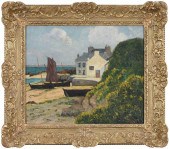 MAXIME MAUFRA(French, 1861-1918) Le
MAXIME MAUFRA(French, 1861-1918) Le Port du Guet (Douarnenez) , circa 1896-1899, signed lower right "M. Maufra", inscribed with title on stretcher, oil on canvas, colormanstamp verso for "Blanchet..Paris", 21-1/4 x 25-5/8 in. (53.34 x 63-1/2 cm.); gilt wood and composition frame, 30 x 34 in. Provenance: Galerie Durand-Ruel, Paris, France; Taylor | Graham Gallery, New York (label verso and with an appraisal and other documents from Abby M. Taylor); Private Bluffton, South Carolina Collection Note: Note from Taylor | Graham Gallery (Abby M. Taylor Fine Art):"In November of 1893, Paul Gauguin visited Maufra and he encouraged Maufra to continue painting according to his own personal conception of Synthetism. Synthetism differed from the earlier Impressionism in how Synthetism emphasized two dimensional flat patterns. Gauguin noticed how Maufra's works were generally not as flat as his own and looked at Maufra as a pioneer, an independent artist going his own way. This meeting marked the start of a six year period for Maufra where he combined the technical aspects of Synthetism with Impressionist subjects". "During this period, Maufra started to capture more detail. His coastal paintings, like Le Port du Guet (Douarnenez) were now able to be identified by location. Details like the particular chimney on the fish house in this painting were captured. This painting was painted in Douarnenez, off the northern coast of Brittany where he spent his summers from 1896-1898. Maufra loved the sea and as Arsene Alexandre puts it in his Maxime Maufra, peintre marin et rustique, 'it was the sea with its perpetual soft and tumultuous currents, its celebrations and tragedies, that dominated his art. Even in many of his paintings in which the sea is not represented, one can still somehow feel it, like and eternal neighbor, constantly acting upon one's life.'. This painting beautifully displays both Maufra's individualism and love for the sea."Caroline Durand-Ruel Godfroy has confirmed the authenticity of this painting. This painting shall be reproduced under n° 290 in the online catalogue critique (https://cataloguemaufra.com). I have not done the latter in FW as I am unsure where to add it at this point. Condition: original stretcher and tacking edge, surface dirt
MAXIME MAUFRA(French, 1861-1918) Le
MAXIME MAUFRA(French, 1861-1918) Le Port du Guet (Douarnenez) , circa 1896-1899, signed lower right "M. Maufra", inscribed with title on stretcher, oil on canvas, colormanstamp verso for "Blanchet..Paris", 21-1/4 x 25-5/8 in. (53.34 x 63-1/2 cm.); gilt wood and composition frame, 30 x 34 in. Provenance: Galerie Durand-Ruel, Paris, France; Taylor | Graham Gallery, New York (label verso and with an appraisal and other documents from Abby M. Taylor); Private Bluffton, South Carolina Collection Note: Note from Taylor | Graham Gallery (Abby M. Taylor Fine Art):"In November of 1893, Paul Gauguin visited Maufra and he encouraged Maufra to continue painting according to his own personal conception of Synthetism. Synthetism differed from the earlier Impressionism in how Synthetism emphasized two dimensional flat patterns. Gauguin noticed how Maufra's works were generally not as flat as his own and looked at Maufra as a pioneer, an independent artist going his own way. This meeting marked the start of a six year period for Maufra where he combined the technical aspects of Synthetism with Impressionist subjects". "During this period, Maufra started to capture more detail. His coastal paintings, like Le Port du Guet (Douarnenez) were now able to be identified by location. Details like the particular chimney on the fish house in this painting were captured. This painting was painted in Douarnenez, off the northern coast of Brittany where he spent his summers from 1896-1898. Maufra loved the sea and as Arsene Alexandre puts it in his Maxime Maufra, peintre marin et rustique, 'it was the sea with its perpetual soft and tumultuous currents, its celebrations and tragedies, that dominated his art. Even in many of his paintings in which the sea is not represented, one can still somehow feel it, like and eternal neighbor, constantly acting upon one's life.'. This painting beautifully displays both Maufra's individualism and love for the sea."Caroline Durand-Ruel Godfroy has confirmed the authenticity of this painting. This painting shall be reproduced under n° 290 in the online catalogue critique (https://cataloguemaufra.com). I have not done the latter in FW as I am unsure where to add it at this point. Condition: original stretcher and tacking edge, surface dirt -
 ATTIC BLACK FIGURE AMPHORA,
ATTIC BLACK FIGURE AMPHORA, LIGHT-MAKE CLASSGreece, Attic, Light-Make Class, ca. 540 to 480 BCE. An exceptional pottery neck amphora, meticulously decorated with hand-painted black-figure technique attributed to the Light-Make Class - a group of Athenian painters whose vases featured black-figure often on white ground. Sitting upon a discoid foot, the opulent vessel displays a bulbous body with a narrow base, a broad, rounded shoulder, a concave neck, and a flared rim. A pair of arched handles gracefully connect neck to shoulder. Skillfully painted, Side A exhibits a lively scene of 3 warriors in battle, all dressed in high-crested helmets and armor as they each hold a shield in 1 hand and a lengthy spear in the other. The central figure sits on 1 knee facing left as the 2 others stand to either side of him, striding toward their fallen foe as they pierce him with their spears. Alternatively, Side B presents the image of a soldier, likely Achilles, flanked by a pair of standing figures or attendants draped in long, bordered himations. Size: 15.2" H (38.6 cm) Also dressed in armor and a helmet, Achilles strides right while looking left and carries a spear and Boeotian shield with a short sword strapped to his waist. His companions face inward, also holding spears or walking sticks. Scrolling vines of palmettes adorn the field and neck of the amphora with 3 on the neck and 4 between each scene accompanied by a hanging lotus bud that falls below each handle. A horizontal band of ray motif stretches up from the foot, followed by a register of polka dots. The area above the figures is additionally decorated with a ring of vertical striations, while a lustrous black glaze envelops the rim, handles, and foot of the elegant vessel. Ancient Athenian painters, including the painter of this vessel, took advantage of the large size of Attic vases which gave them more room to explore their techniques, overlap figures, present complex interactions between figures, create depth and attempt renderings of perspective. These techniques are certainly present in the Iliad-inspired scenes that we see here. Achilles was the son of the nereid or sea nymph Thetis and the mortal Peleus, king of the Myrmidons. Renowned as the mightiest warrior of the army of Agamemnon in the Trojan War, during his childhood, Thetis dipped Achilles in the waters of the River Styx which rendered him invincible, except for the section of his heel by which Thetis held him; hence the term "Achilles' heel." Cf. Princeton University, Art Museum, y1933-46 and Beazley Archive, 310390. Provenance: private New York, New York, USA collection; ex-private prominent D.K. collection, New York, USA, acquired in the 2000s All items legal to buy/sell under U.S. Statute covering cultural patrimony Code 2600, CHAPTER 14, and are guaranteed to be as described or your money back. A Certificate of Authenticity will accompany all winning bids. PLEASE NOTE: Due to recent increases of shipments being seized by Australian & German customs (even for items with pre-UNESCO provenance), we will no longer ship most antiquities and ancient Chinese art to Australia & Germany. For categories of items that are acceptable to ship to Australia or Germany, please contact us directly or work with your local customs brokerage firm. Display stands not described as included/custom in the item description are for photography purposes only and will not be included with the item upon shipping. #170413 Condition: Professionally repaired with restoration and re-painting over break lines. Visible chipping to rim. Possible other areas of re-painting. Expected nicks, pitting, and abrasions, throughout, commensurate with age. Otherwise, excellent with impressive preservation of detail.
ATTIC BLACK FIGURE AMPHORA,
ATTIC BLACK FIGURE AMPHORA, LIGHT-MAKE CLASSGreece, Attic, Light-Make Class, ca. 540 to 480 BCE. An exceptional pottery neck amphora, meticulously decorated with hand-painted black-figure technique attributed to the Light-Make Class - a group of Athenian painters whose vases featured black-figure often on white ground. Sitting upon a discoid foot, the opulent vessel displays a bulbous body with a narrow base, a broad, rounded shoulder, a concave neck, and a flared rim. A pair of arched handles gracefully connect neck to shoulder. Skillfully painted, Side A exhibits a lively scene of 3 warriors in battle, all dressed in high-crested helmets and armor as they each hold a shield in 1 hand and a lengthy spear in the other. The central figure sits on 1 knee facing left as the 2 others stand to either side of him, striding toward their fallen foe as they pierce him with their spears. Alternatively, Side B presents the image of a soldier, likely Achilles, flanked by a pair of standing figures or attendants draped in long, bordered himations. Size: 15.2" H (38.6 cm) Also dressed in armor and a helmet, Achilles strides right while looking left and carries a spear and Boeotian shield with a short sword strapped to his waist. His companions face inward, also holding spears or walking sticks. Scrolling vines of palmettes adorn the field and neck of the amphora with 3 on the neck and 4 between each scene accompanied by a hanging lotus bud that falls below each handle. A horizontal band of ray motif stretches up from the foot, followed by a register of polka dots. The area above the figures is additionally decorated with a ring of vertical striations, while a lustrous black glaze envelops the rim, handles, and foot of the elegant vessel. Ancient Athenian painters, including the painter of this vessel, took advantage of the large size of Attic vases which gave them more room to explore their techniques, overlap figures, present complex interactions between figures, create depth and attempt renderings of perspective. These techniques are certainly present in the Iliad-inspired scenes that we see here. Achilles was the son of the nereid or sea nymph Thetis and the mortal Peleus, king of the Myrmidons. Renowned as the mightiest warrior of the army of Agamemnon in the Trojan War, during his childhood, Thetis dipped Achilles in the waters of the River Styx which rendered him invincible, except for the section of his heel by which Thetis held him; hence the term "Achilles' heel." Cf. Princeton University, Art Museum, y1933-46 and Beazley Archive, 310390. Provenance: private New York, New York, USA collection; ex-private prominent D.K. collection, New York, USA, acquired in the 2000s All items legal to buy/sell under U.S. Statute covering cultural patrimony Code 2600, CHAPTER 14, and are guaranteed to be as described or your money back. A Certificate of Authenticity will accompany all winning bids. PLEASE NOTE: Due to recent increases of shipments being seized by Australian & German customs (even for items with pre-UNESCO provenance), we will no longer ship most antiquities and ancient Chinese art to Australia & Germany. For categories of items that are acceptable to ship to Australia or Germany, please contact us directly or work with your local customs brokerage firm. Display stands not described as included/custom in the item description are for photography purposes only and will not be included with the item upon shipping. #170413 Condition: Professionally repaired with restoration and re-painting over break lines. Visible chipping to rim. Possible other areas of re-painting. Expected nicks, pitting, and abrasions, throughout, commensurate with age. Otherwise, excellent with impressive preservation of detail. -
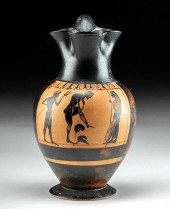 ATTIC BLACK-FIGURE OINOCHOE W/
ATTIC BLACK-FIGURE OINOCHOE W/ ACHILLES, EX-CHRISTIE'SAncient Greece, Athens (Attic), ca. 530 BCE. Finely decorated via the black-figure technique with incised and added fugitive red painted details, a beautiful trefoil oinochoe featuring the scene of a warrior - perhaps Achilles - readying himself for battle; the nude figure bending over to put on his greaves as a high-crested Corinthian helmet rests at his feet and a draped woman, possibly Achille's mother Thetis, and a young man stand to either side. Greaves and ankle guards were hammered from sheet bronze and retained considerable tensile strength, allowing them to be snapped onto the raised leg, as seen here. The woman watches while holding the warrior's spear and shield, serving as an attendant. Behind him, the nude youth holds another spear, likely waiting to arm himself as well. A band of tongues decorates the area above, just below the trefoil spout of the vessel. Though the warrior's armor indicates he may be a hoplite, this may also be a representation of the arming of Achilles by his mother Thetis. Size: 4.2" Diameter x 7.4" H (10.7 cm x 18.8 cm) According to Homer's Iliad, during the last year of the Trojan war, Patroclus, Achilles’s beloved friend, dons Achilles' armor in order to scare the Trojans back from the beaches of Greece. He succeeds in doing so but is killed by Hector and stripped of the armor in the process, leaving Achilles grief-stricken and armorless. Thetis comes to comfort her son and, after seeing his deep despair, persuades Hephaestus, the god of blacksmiths and craftsmen, to forge him new armor. The god accepts and makes a shield, a breastplate, a helmet, and greaves, which Thetis delivers to Achilles, as seen in this example. Enraged, Achilles then returns to battle with the sole aim of avenging Patroclus’ death by killing Hector, despite a warning that doing so would cost him his life. After defeating Hector, Achilles drags his corpse by the heels behind his chariot. Athens mandated that all 18- to 20-year-olds participate in military service; however, during times of war, all male citizens through the age of 60 could be asked to serve. Hoplites carried a large, round, bronze-faced shield known as a hoplon in one hand, as seen in this example, and, in the other, an eight-foot-long wooden spear with a leaf-shaped iron head and a bronze butt spike. The butt spike was known as a sauroter, a "lizard killer," and, if the spear was broken, could be used as a weapon on the remaining end. It could also be used to stand the spear in soft ground or as a digging tool. Scenes of warriors preparing for battle were quite popular in Ancient Greece and can be found on vessels in the Metropolitan Museum of Art (06.1021.164a, b), the Fitzwilliam Museum at Cambridge University (GR.6.1917), the Louvre (E813), Rijksmuseum van Oudheden (PC60), and the Athens Agora Museum (P24360). Published: Christie's London (South Kensington), "Antiquities" (October 5, 2000), no. 195.; J. Eisenberg, "Art of the Ancient World, vol. XIII" (2002), no. 81; Ancient Arms, Armor (2004), no. 48; 1000 Years of Ancient Greek Vases II (2010), no. 72. Provenance: ex-Royal Athena Galleries, New York City, New York, USA; ex-English collection; ex-Christie's South Kensington, London, United Kingdom, October 5th, 2000, sale 8724, lot 195 All items legal to buy/sell under U.S. Statute covering cultural patrimony Code 2600, CHAPTER 14, and are guaranteed to be as described or your money back. A Certificate of Authenticity will accompany all winning bids. We ship worldwide and handle all shipping in-house for your convenience. #175405 Condition: Possible minor repair to one of the lobes of the trefoil lip. Some areas of overpainting. Some minor nicks to rim and surface. Otherwise, excellent with great remaining detail and pigments.
ATTIC BLACK-FIGURE OINOCHOE W/
ATTIC BLACK-FIGURE OINOCHOE W/ ACHILLES, EX-CHRISTIE'SAncient Greece, Athens (Attic), ca. 530 BCE. Finely decorated via the black-figure technique with incised and added fugitive red painted details, a beautiful trefoil oinochoe featuring the scene of a warrior - perhaps Achilles - readying himself for battle; the nude figure bending over to put on his greaves as a high-crested Corinthian helmet rests at his feet and a draped woman, possibly Achille's mother Thetis, and a young man stand to either side. Greaves and ankle guards were hammered from sheet bronze and retained considerable tensile strength, allowing them to be snapped onto the raised leg, as seen here. The woman watches while holding the warrior's spear and shield, serving as an attendant. Behind him, the nude youth holds another spear, likely waiting to arm himself as well. A band of tongues decorates the area above, just below the trefoil spout of the vessel. Though the warrior's armor indicates he may be a hoplite, this may also be a representation of the arming of Achilles by his mother Thetis. Size: 4.2" Diameter x 7.4" H (10.7 cm x 18.8 cm) According to Homer's Iliad, during the last year of the Trojan war, Patroclus, Achilles’s beloved friend, dons Achilles' armor in order to scare the Trojans back from the beaches of Greece. He succeeds in doing so but is killed by Hector and stripped of the armor in the process, leaving Achilles grief-stricken and armorless. Thetis comes to comfort her son and, after seeing his deep despair, persuades Hephaestus, the god of blacksmiths and craftsmen, to forge him new armor. The god accepts and makes a shield, a breastplate, a helmet, and greaves, which Thetis delivers to Achilles, as seen in this example. Enraged, Achilles then returns to battle with the sole aim of avenging Patroclus’ death by killing Hector, despite a warning that doing so would cost him his life. After defeating Hector, Achilles drags his corpse by the heels behind his chariot. Athens mandated that all 18- to 20-year-olds participate in military service; however, during times of war, all male citizens through the age of 60 could be asked to serve. Hoplites carried a large, round, bronze-faced shield known as a hoplon in one hand, as seen in this example, and, in the other, an eight-foot-long wooden spear with a leaf-shaped iron head and a bronze butt spike. The butt spike was known as a sauroter, a "lizard killer," and, if the spear was broken, could be used as a weapon on the remaining end. It could also be used to stand the spear in soft ground or as a digging tool. Scenes of warriors preparing for battle were quite popular in Ancient Greece and can be found on vessels in the Metropolitan Museum of Art (06.1021.164a, b), the Fitzwilliam Museum at Cambridge University (GR.6.1917), the Louvre (E813), Rijksmuseum van Oudheden (PC60), and the Athens Agora Museum (P24360). Published: Christie's London (South Kensington), "Antiquities" (October 5, 2000), no. 195.; J. Eisenberg, "Art of the Ancient World, vol. XIII" (2002), no. 81; Ancient Arms, Armor (2004), no. 48; 1000 Years of Ancient Greek Vases II (2010), no. 72. Provenance: ex-Royal Athena Galleries, New York City, New York, USA; ex-English collection; ex-Christie's South Kensington, London, United Kingdom, October 5th, 2000, sale 8724, lot 195 All items legal to buy/sell under U.S. Statute covering cultural patrimony Code 2600, CHAPTER 14, and are guaranteed to be as described or your money back. A Certificate of Authenticity will accompany all winning bids. We ship worldwide and handle all shipping in-house for your convenience. #175405 Condition: Possible minor repair to one of the lobes of the trefoil lip. Some areas of overpainting. Some minor nicks to rim and surface. Otherwise, excellent with great remaining detail and pigments. -
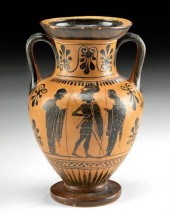 GREEK ATTIC BLACK-FIGURE AMPHORA,
GREEK ATTIC BLACK-FIGURE AMPHORA, LIGHT-MAKE CLASS**First Time At Auction** Greece, Attic, attributed to the Light-Make Class, ca. 540 to 480 BCE. A splendid pottery neck amphora boasting skillfully painted black-figure decoration of 3 battling warriors on one side and the famed hero Achilles on the other. On side A, a fully-armed Achilles strides right surrounded by robed figures, perhaps attendants or fellow warriors, all grasping spears that add dynamic visual lines to the scene. Clad in a high-crested helmet and large shield, our hero turns his head left as though addressing one of the figures. Alternatively, side B displays 3 warriors in battle, all dressed in helmets and armor as they each hold a shield in 1 hand and a lengthy spear in the other. The central figure has seemingly fallen to his knee as the 2 others stand to either side of him, striding toward their fallen foe as they pierce him with their spears. Size: 4" Diameter x 6" H (10.2 cm x 15.2 cm) The remainder of the vessel is elaborately adorned with scrolling palmettes that separate the sides and decorate the neck, a tongued pattern above each scene, and rays with a dotted design below. All of this lavish ornamentation is nicely complemented by the elegant silhouette of the vessel, which presents a classic form of a discoid foot, broad, a rounded shoulders, a tall neck, and a pair of arched, trifurcated handles that connect the shoulders to the flared rim. Achilles was the son of the nereid or sea nymph Thetis and the mortal Peleus, king of the Myrmidons. Renowned as the mightiest warrior of the army of Agamemnon in the Trojan War, during his childhood, Thetis dipped Achilles in the waters of the River Styx which rendered him invincible, except for the section of his heel by which Thetis held him; hence the term "Achilles' heel." This amphora is attributed to a group of Athenian painters whom Beazley named The Light-Make Group, due to their light color palette. The Light-Make Group is known for Athenian black-figure vases of similar shape, often with a white ground. PLEASE NOTE: Due to recent increases of shipments being seized by Australian & German customs (even for items with pre-UNESCO provenance), we will no longer ship most antiquities and ancient Chinese art to Australia & Germany. For categories of items that are acceptable to ship to Australia or Germany, please contact us directly or work with your local customs brokerage firm. Provenance: private New York, New York, USA collection; ex-private prominent Daryl Kulok collection, New York, USA, acquired in the 2000s All items legal to buy/sell under U.S. Statute covering cultural patrimony Code 2600, CHAPTER 14, and are guaranteed to be as described or your money back. A Certificate of Authenticity will accompany all winning bids. We ship worldwide and handle all shipping in-house for your convenience. #177223 Condition: Professionally repaired with restoration and re-painting over break lines. Visible chipping to rim. Expected nicks, pitting, and abrasions, throughout, commensurate with age. Otherwise, excellent with impressive preservation of detail.
GREEK ATTIC BLACK-FIGURE AMPHORA,
GREEK ATTIC BLACK-FIGURE AMPHORA, LIGHT-MAKE CLASS**First Time At Auction** Greece, Attic, attributed to the Light-Make Class, ca. 540 to 480 BCE. A splendid pottery neck amphora boasting skillfully painted black-figure decoration of 3 battling warriors on one side and the famed hero Achilles on the other. On side A, a fully-armed Achilles strides right surrounded by robed figures, perhaps attendants or fellow warriors, all grasping spears that add dynamic visual lines to the scene. Clad in a high-crested helmet and large shield, our hero turns his head left as though addressing one of the figures. Alternatively, side B displays 3 warriors in battle, all dressed in helmets and armor as they each hold a shield in 1 hand and a lengthy spear in the other. The central figure has seemingly fallen to his knee as the 2 others stand to either side of him, striding toward their fallen foe as they pierce him with their spears. Size: 4" Diameter x 6" H (10.2 cm x 15.2 cm) The remainder of the vessel is elaborately adorned with scrolling palmettes that separate the sides and decorate the neck, a tongued pattern above each scene, and rays with a dotted design below. All of this lavish ornamentation is nicely complemented by the elegant silhouette of the vessel, which presents a classic form of a discoid foot, broad, a rounded shoulders, a tall neck, and a pair of arched, trifurcated handles that connect the shoulders to the flared rim. Achilles was the son of the nereid or sea nymph Thetis and the mortal Peleus, king of the Myrmidons. Renowned as the mightiest warrior of the army of Agamemnon in the Trojan War, during his childhood, Thetis dipped Achilles in the waters of the River Styx which rendered him invincible, except for the section of his heel by which Thetis held him; hence the term "Achilles' heel." This amphora is attributed to a group of Athenian painters whom Beazley named The Light-Make Group, due to their light color palette. The Light-Make Group is known for Athenian black-figure vases of similar shape, often with a white ground. PLEASE NOTE: Due to recent increases of shipments being seized by Australian & German customs (even for items with pre-UNESCO provenance), we will no longer ship most antiquities and ancient Chinese art to Australia & Germany. For categories of items that are acceptable to ship to Australia or Germany, please contact us directly or work with your local customs brokerage firm. Provenance: private New York, New York, USA collection; ex-private prominent Daryl Kulok collection, New York, USA, acquired in the 2000s All items legal to buy/sell under U.S. Statute covering cultural patrimony Code 2600, CHAPTER 14, and are guaranteed to be as described or your money back. A Certificate of Authenticity will accompany all winning bids. We ship worldwide and handle all shipping in-house for your convenience. #177223 Condition: Professionally repaired with restoration and re-painting over break lines. Visible chipping to rim. Expected nicks, pitting, and abrasions, throughout, commensurate with age. Otherwise, excellent with impressive preservation of detail. -
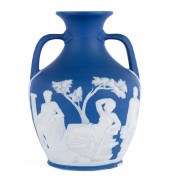 BLUE AND WHITE WEDGWOOD PORTLAND
BLUE AND WHITE WEDGWOOD PORTLAND VASEBLUE AND WHITE WEDGWOOD PORTLAND VASE English, mid-19th century, jasperware. Replica of the Portland vase housed in the British Museum. Frieze of the marriage of Peleus and Thetis and the marriage of Paris and Helen, thus referencing the fall of Troy and the rise of Rome. The underside of relief decoration, hallmarked. 10 1/4 in. (26 cm.) Collection of Ms. Geneva B. Williams, Illinois Condition: Any condition statement is given as a courtesy to a client, is an opinion, and should not be treated as a statement of fact. Reference to condition written, oral or within a condition report shall not be regarded as a full account of condition and may not include all defects, alterations, or restorations. Absence of a condition report does not imply a lot is flawless or lacking imperfections or damage. Selkirk Auctioneers & Appraisers shall have no responsibility for any error or omission. Returns shall not be accepted on the basis of condition.
BLUE AND WHITE WEDGWOOD PORTLAND
BLUE AND WHITE WEDGWOOD PORTLAND VASEBLUE AND WHITE WEDGWOOD PORTLAND VASE English, mid-19th century, jasperware. Replica of the Portland vase housed in the British Museum. Frieze of the marriage of Peleus and Thetis and the marriage of Paris and Helen, thus referencing the fall of Troy and the rise of Rome. The underside of relief decoration, hallmarked. 10 1/4 in. (26 cm.) Collection of Ms. Geneva B. Williams, Illinois Condition: Any condition statement is given as a courtesy to a client, is an opinion, and should not be treated as a statement of fact. Reference to condition written, oral or within a condition report shall not be regarded as a full account of condition and may not include all defects, alterations, or restorations. Absence of a condition report does not imply a lot is flawless or lacking imperfections or damage. Selkirk Auctioneers & Appraisers shall have no responsibility for any error or omission. Returns shall not be accepted on the basis of condition. -
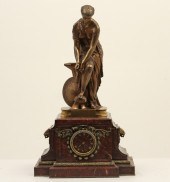 19TH C. SIGNED BRONZE AND MARBLE
19TH C. SIGNED BRONZE AND MARBLE FIGURAL CLOCK Signed classical bronze figure of seated lady titled "Thetis" signed on base Emile Hebert, resting on a conforming rouge and bronze mounted clock pedestal, 19th C.; 30"H 17"W 11"D
19TH C. SIGNED BRONZE AND MARBLE
19TH C. SIGNED BRONZE AND MARBLE FIGURAL CLOCK Signed classical bronze figure of seated lady titled "Thetis" signed on base Emile Hebert, resting on a conforming rouge and bronze mounted clock pedestal, 19th C.; 30"H 17"W 11"D -
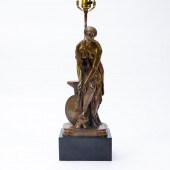 BRONZE FIGURE OF THETIS, MOUNTED AS
BRONZE FIGURE OF THETIS, MOUNTED AS A LAMP After Pierre-Eugene-Emile Hebert (French, 1823-1893), late 19th or 20th century. Bronze figure of the Greek mythical of goddess or nymph Thetis, now mounted as a lamp on an ebonized wooden base. Signed in cast. Approx. h. 15" (figure); h. 31" (overall).
BRONZE FIGURE OF THETIS, MOUNTED AS
BRONZE FIGURE OF THETIS, MOUNTED AS A LAMP After Pierre-Eugene-Emile Hebert (French, 1823-1893), late 19th or 20th century. Bronze figure of the Greek mythical of goddess or nymph Thetis, now mounted as a lamp on an ebonized wooden base. Signed in cast. Approx. h. 15" (figure); h. 31" (overall). -
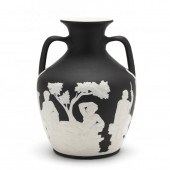 WEDGWOOD LIMITED EDITION OF THE
WEDGWOOD LIMITED EDITION OF THE PORTLAND VASE #6 of 21, black basalt with applied cameo elements in a classical scene of the myth of Peleus and Thetis, decorated even to the underside of the vase. Minute impressed stamp to the exterior rim "Wedgwood Made in England".(Peleus and Thetis were the parents of the Homer's heroic Achilles).
WEDGWOOD LIMITED EDITION OF THE
WEDGWOOD LIMITED EDITION OF THE PORTLAND VASE #6 of 21, black basalt with applied cameo elements in a classical scene of the myth of Peleus and Thetis, decorated even to the underside of the vase. Minute impressed stamp to the exterior rim "Wedgwood Made in England".(Peleus and Thetis were the parents of the Homer's heroic Achilles).
...many more examples with full details are available to our members - Learn more


